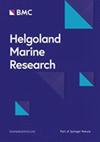在不同混凝土混合物上建立底栖生物群落引入德国深水港
4区 地球科学
Q2 Agricultural and Biological Sciences
引用次数: 1
摘要
混凝土是世界各国沿海建筑中广泛使用的一种建筑材料。然而,生产过程中使用的有限的自然资源,以及石灰石煅烧过程产生的高二氧化碳排放和波特兰水泥熟料生产的热能需求,提高了对替代成分的需求。替代混合物类型应该是环保的,最好是模仿自然的硬基质。在这里制作了五种不同的混凝土混合物,含有不同的水泥(波特兰水泥和高炉水泥)和骨料(砂、砾石、铁矿石和冶金渣)。然后将每种类型的三个复制立方体(15 × 15 × 15 cm)放置在德国深水港JadeWeserPort,研究一年后底栖生物群落的建立。结果与在自然硬地环境中进行的类似实验(德国Helgoland岛)进行了比较。结果表明,与自然环境相比,港口遗址的定居社区存在显著差异。在港口地区,社区组成与混凝土混合物没有差异。立方体的表面朝向(前/上/后)显示出物种丰度和组成的显著差异。在港口场地,立方体比在自然硬地面环境中容纳更多的新生物。讨论了使用新型混凝土混合料的意义。本文章由计算机程序翻译,如有差异,请以英文原文为准。
Benthic community establishment on different concrete mixtures introduced to a German deep-water port
Concrete is a widely used building material in coastal constructions worldwide. However, limited natural resources used in the production process, as well as high CO2-emission due to the calcination process of limestone and the thermal energy demand for Portland cement clinker production, raise the demand for alternative constituents. Alternative mixture types should be environmentally friendly and, at best, mimic natural hard substrates. Here five different concrete mixtures, containing different cements (Portland cement and blast furnace cements) and aggregates (sand, gravel, iron ore and metallurgical slags) were made. Three replicate cubes (15 × 15 × 15 cm) of each type were then deployed in a German deep-water Port, the JadeWeserPort, to study benthic community establishment after one year. Results are compared to a similar experiment conducted in a natural hard ground environment (Helgoland Island, Germany). Results indicate marked differences in settled communities in the Port site compared to natural environments. At the Port site community composition did not differ with the concrete mixtures. Surface orientation of the cubes (front/top/back) revealed significant differences in species abundances and compositions. Cubes hold more neobiota in the Port site than in natural hard ground environments. Implications for the usage of new concrete mixtures are discussed.
求助全文
通过发布文献求助,成功后即可免费获取论文全文。
去求助
来源期刊

Helgoland Marine Research
地学-海洋学
自引率
0.00%
发文量
0
审稿时长
6-12 weeks
期刊介绍:
Helgoland Marine Research is an open access, peer reviewed journal, publishing original research as well as reviews on all aspects of marine and brackish water ecosystems, with a focus on how organisms survive in, and interact with, their environment.
The aim of Helgoland Marine Research is to publish work with a regional focus, but with clear global implications, or vice versa; research with global emphasis and regional ramifications. We are particularly interested in contributions that further our general understanding of how marine ecosystems work, and that concentrate on species’ interactions.
 求助内容:
求助内容: 应助结果提醒方式:
应助结果提醒方式:


